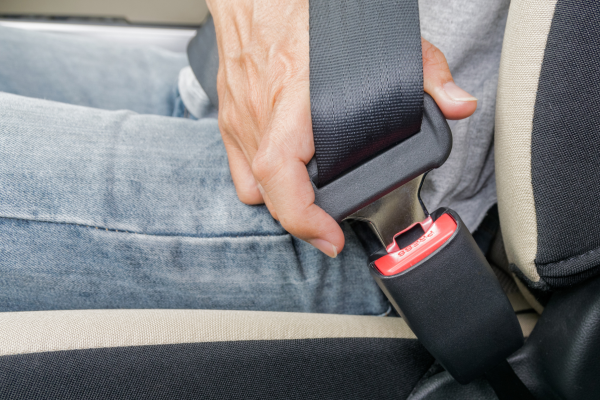Vehicle Safety
Fixing Slow-Retracting Seat Belts: A How-To Guide

Fixing Slow-Retracting Seat Belts: A How-To Guide
Is your seat belt refusing to retract smoothly, causing frustration during every drive? You're not alone. Slow-retracting seat belts can be more than just an inconvenience-they can pose safety risks as well. In this how-to guide, we'll explore the workings of seat belt mechanisms, identify common issues that lead to slow retraction, and provide a step-by-step approach to fixing the problem. Whether you're a car owner tackling DIY repairs or an automotive repair professional refining your skills, this article has something for everyone.
Key Takeaways
- Understanding how seat belts work is crucial for effective maintenance.
-
- Common issues such as dirt accumulation can lead to slow-retracting seat belts.
-
- A detailed, step-by-step guide helps car owners troubleshoot seat belt problems.
-
- Preventive maintenance can extend the lifespan of your seat belts and improve safety.
-
- Regularly checking seat belts is key to ensuring optimal performance and functionality.
Understanding the Mechanism of Seat Belts
Understanding the mechanics behind seat belts is crucial, especially when tackling issues like slow retraction. These safety devices function through intricate components, including a retracting mechanism that utilizes springs and rollers. When they fail, it can compromise effectiveness, making it essential to identify causes like dirt buildup, damaged components, or misalignment. To fix slow-retracting seat belts, follow these steps:
- Inspect the Seat Belt: Check for obstructions or tangles.
-
- Clean the Belt: Use a mild solution to remove grime that may hinder retraction.
-
- Check the Retractor Mechanism: Look for wear or damage, and replace faulty parts if necessary.
Preventive maintenance is key! Regularly inspect and clean your seat belts, store your vehicle in a garage, and avoid overextending the belts during use. These measures help keep your seat belts in optimal working condition.
Common Causes of Slow-Retracting Seat Belts
A seat belt operates through a series of components, including a retractor that extends and retracts the belt smoothly during use. When it fails to retract fully, common causes include:
- Dirt Build-Up: Debris accumulation can hinder smooth retraction.
-
- Malfunctioning Inertia Reel: A faulty reel can impact retraction.
-
- Worn-Out Components: Old or damaged parts can slow retraction.
Troubleshooting Steps
- Inspect for Obstructions: Check for visible debris.
-
- Clean the Retractor Mechanism: Use a soft cloth and cleaner.
-
- Disassemble if Needed: For persistent issues, carefully disassemble for a more detailed check.
-
- Examine the Webbing: Ensure the belt is free of twists or damage.
To prevent issues, maintain seat belts by keeping them clean, avoiding excessive force when retracting, and periodically inspecting them for wear.
"The bitterness of poor quality remains long after the sweetness of low price is forgotten."-Benjamin Franklin
Step-by-Step Guide to Fixing Slow-Retracting Seat Belts
Fixing slow-retracting seat belts can be straightforward with the right tools and patience. Follow these steps:
- Determine the Cause: Often, dirt or debris in the retractor is the culprit.
-
- Remove the Seat Belt from Anchor Point: Carefully unhook the seat belt.
-
- Inspect and Clean: Use a microfiber cloth to wipe down the belt.
-
- Lubricate the Retractor Mechanism: Use a silicone spray (avoid overspray on the fabric).
-
- Reattach the Belt: Ensure its anchored correctly and free from twists.
Test the belt several times to confirm it retracts smoothly. Following these steps will have your seat belts functioning properly, ensuring both safety and comfort for you and your passengers.
Preventive Maintenance Tips for Seat Belts
Performing regular maintenance on your seat belts can significantly enhance safety and convenience:
- Inspect for Wear: Ensure that the webbing is not frayed or twisted.
-
- Check the Retractor Mechanism: Clean away any dirt or debris.
-
- Lubricate if Necessary: A silicone spray can keep the retractor functioning smoothly (avoid oil-based products).
-
- Secure Anchor Points: Make sure anchor points are tight to avoid unnecessary belt tension.
Regular preventive maintenance can help car owners keep seat belts functioning well and avoid safety issues over time.
Frequently Asked Questions
What are the common causes of slow-retracting seat belts?
Dirt or debris in the mechanism, a damaged retractor spring, incorrect winding of the seat belt, or general wear and tear over time are common causes.
Can I fix slow-retracting seat belts myself, or should I take it to a professional?
You can often fix slow-retracting seat belts by following this guide. However, if you're uncomfortable with DIY repairs or the problem persists, consult a professional.
What tools do I need to fix a slow-retracting seat belt?
Typically, basic hand tools like a screwdriver, pliers, and a flashlight for better visibility are sufficient.
How often should I perform preventive maintenance on my seat belts?
It's advisable to inspect seat belts at least once a year. Regular cleaning and checks for signs of wear or damage help ensure safety and functionality.
Is it safe to use a car with slow-retracting seat belts?
While it may still function, slow-retracting seat belts compromise safety by not securing passengers properly. Address the issue as soon as possible.
Slow-retracting seat belts can be a frustrating and potentially unsafe issue, but with some DIY effort, you can restore their functionality. By cleaning, inspecting, and occasionally lubricating the seat belt mechanism, you ensure they remain in top working condition.
For persistent issues, consult a professional service like L&D Solutions to safely address retraction issues, so your vehicle stays both comfortable and secure for every journey.
Fixing Slow-Retracting Seat Belts: A How-To Guide
Is your seat belt refusing to retract smoothly, causing frustration during every drive? You're not alone. Slow-retracting seat belts can be more than just an inconvenience-they can pose safety risks as well. In this how-to guide, we'll explore the workings of seat belt mechanisms, identify common issues that lead to slow retraction, and provide a step-by-step approach to fixing the problem. Whether you're a car owner tackling DIY repairs or an automotive repair professional refining your skills, this article has something for everyone.
Key Takeaways
- Understanding how seat belts work is crucial for effective maintenance.
-
- Common issues such as dirt accumulation can lead to slow-retracting seat belts.
-
- A detailed, step-by-step guide helps car owners troubleshoot seat belt problems.
-
- Preventive maintenance can extend the lifespan of your seat belts and improve safety.
-
- Regularly checking seat belts is key to ensuring optimal performance and functionality.
Understanding the Mechanism of Seat Belts
Understanding the mechanics behind seat belts is crucial, especially when tackling issues like slow retraction. These safety devices function through intricate components, including a retracting mechanism that utilizes springs and rollers. When they fail, it can compromise effectiveness, making it essential to identify causes like dirt buildup, damaged components, or misalignment. To fix slow-retracting seat belts, follow these steps:
- Inspect the Seat Belt: Check for obstructions or tangles.
-
- Clean the Belt: Use a mild solution to remove grime that may hinder retraction.
-
- Check the Retractor Mechanism: Look for wear or damage, and replace faulty parts if necessary.
Preventive maintenance is key! Regularly inspect and clean your seat belts, store your vehicle in a garage, and avoid overextending the belts during use. These measures help keep your seat belts in optimal working condition.
Common Causes of Slow-Retracting Seat Belts
A seat belt operates through a series of components, including a retractor that extends and retracts the belt smoothly during use. When it fails to retract fully, common causes include:
- Dirt Build-Up: Debris accumulation can hinder smooth retraction.
-
- Malfunctioning Inertia Reel: A faulty reel can impact retraction.
-
- Worn-Out Components: Old or damaged parts can slow retraction.
Troubleshooting Steps
- Inspect for Obstructions: Check for visible debris.
-
- Clean the Retractor Mechanism: Use a soft cloth and cleaner.
-
- Disassemble if Needed: For persistent issues, carefully disassemble for a more detailed check.
-
- Examine the Webbing: Ensure the belt is free of twists or damage.
To prevent issues, maintain seat belts by keeping them clean, avoiding excessive force when retracting, and periodically inspecting them for wear.
"The bitterness of poor quality remains long after the sweetness of low price is forgotten."-Benjamin Franklin
Step-by-Step Guide to Fixing Slow-Retracting Seat Belts
Fixing slow-retracting seat belts can be straightforward with the right tools and patience. Follow these steps:
- Determine the Cause: Often, dirt or debris in the retractor is the culprit.
-
- Remove the Seat Belt from Anchor Point: Carefully unhook the seat belt.
-
- Inspect and Clean: Use a microfiber cloth to wipe down the belt.
-
- Lubricate the Retractor Mechanism: Use a silicone spray (avoid overspray on the fabric).
-
- Reattach the Belt: Ensure its anchored correctly and free from twists.
Test the belt several times to confirm it retracts smoothly. Following these steps will have your seat belts functioning properly, ensuring both safety and comfort for you and your passengers.
Preventive Maintenance Tips for Seat Belts
Performing regular maintenance on your seat belts can significantly enhance safety and convenience:
- Inspect for Wear: Ensure that the webbing is not frayed or twisted.
-
- Check the Retractor Mechanism: Clean away any dirt or debris.
-
- Lubricate if Necessary: A silicone spray can keep the retractor functioning smoothly (avoid oil-based products).
-
- Secure Anchor Points: Make sure anchor points are tight to avoid unnecessary belt tension.
Regular preventive maintenance can help car owners keep seat belts functioning well and avoid safety issues over time.
Frequently Asked Questions
What are the common causes of slow-retracting seat belts?
Dirt or debris in the mechanism, a damaged retractor spring, incorrect winding of the seat belt, or general wear and tear over time are common causes.
Can I fix slow-retracting seat belts myself, or should I take it to a professional?
You can often fix slow-retracting seat belts by following this guide. However, if you're uncomfortable with DIY repairs or the problem persists, consult a professional.
What tools do I need to fix a slow-retracting seat belt?
Typically, basic hand tools like a screwdriver, pliers, and a flashlight for better visibility are sufficient.
How often should I perform preventive maintenance on my seat belts?
It's advisable to inspect seat belts at least once a year. Regular cleaning and checks for signs of wear or damage help ensure safety and functionality.
Is it safe to use a car with slow-retracting seat belts?
While it may still function, slow-retracting seat belts compromise safety by not securing passengers properly. Address the issue as soon as possible.
Slow-retracting seat belts can be a frustrating and potentially unsafe issue, but with some DIY effort, you can restore their functionality. By cleaning, inspecting, and occasionally lubricating the seat belt mechanism, you ensure they remain in top working condition.
For persistent issues, consult a professional service like L&D Solutions to safely address retraction issues, so your vehicle stays both comfortable and secure for every journey.


